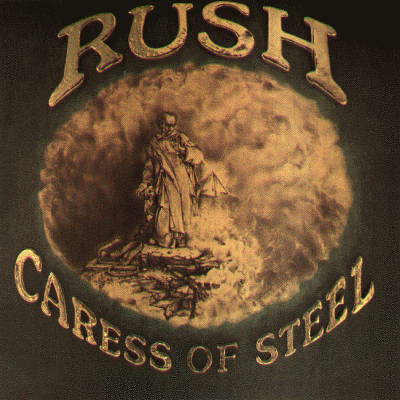 |
From the Vault...
11/18/2001
#760 |

|
info
Rush
"Caress Of Steel"
© RCA/BMG Records
Year of Release: 1975
Rating:


|
track listing
Bastille Day
I Think I'm Going Bald
Lakeside Park
The Necromancer
The Fountain Of
Lamneth
|
WSVNRadio Archives
Rush related sites:
|
|
|
Rush
"Caress Of Steel"
My fondest memories of Canada's Rush were during my high school years
(1979-1982). The top 3 bands on everyone's mind at the time, were Rush, R.E.O.
Speedwagon, and Styx. (AC/DC would follow in my senior year). Categorizing
their music, we can agree that the first three bands mentioned were categorized
as Progressive Rock, (of course both R.E.O. and Styx would become more
pop-oriented in their later years), Rush has always stayed with their musical
style; that being a band that could be recognized as Classic Rock, Progressive
Rock, Art-Rock, and maybe even Heavy Metal.
But recollecting my memories of Rush's albums, Caress Of Steel was
one of many I did not remember. Maybe because there were not any major hits
played on radio, due to the fact that two of the songs were 12 and 19 minutes
in length. Albums such as Permanent Waves, 2112, Rush, Fly By Night
and Moving Pictures had many hits well-played on radio. Caress Of
Steel was Rush's third chronological album, and since the albums before
and after this release, it's interesting to hear this album, because it
was released in the peak of the band's career, and to see if it would be equally
popular.
Progressive Rock and Heavy Metal fans alike will surely enjoy the opening
track, "Bastille Day." It definitely defines hard rock at its best, and
being a song less than 5 minutes in length, it could have easily been exposed
to popular radio airplay. And with lead singer Geddy Lee's unmistakable voice,
Rock fans easily can tell that this song is by Rush.
We can also say the same for the near-4 minute song, "I Think I'm Going
Bald." Having a more hard-rock edge, this one could easily get radio airplay
exposure, but with the title of this song, many would probably not want to refer
to it, yet alone the song itself is a good rock number. "Lakeside Park"
is another 4-minute number, having a more Progressive Rock sound. It may not
be as powerful for radio airplay, being a mild song.
Now for the lengthy compositions...
"The Necromancer" (12 minutes)
I can't help but hearing the likes of Pink Floyd's Wish You Were Here
on Into The Darkness, the first phase of "The Necromancer."
(the first 4 minutes). The second phase, Under The Shadow, has a Led
Zeppelin approach, something possibly from their Physical Graffitti
release, yet with a much harder edge. Spoken word dialogue is featured in
the first and third phase, Return Of The Prince, which reminds me of
the solo works of Yes' keyboardist, Rick Wakeman. At the 8-minute mark, the
remaining phase, has a softer sound, and the music reminds me of The Velvet
Underground's "Sweet Jane." An interesting piece of work, with different
progressions, a feature many Progressive Rock bands have done. Rush would
later perfect this style on their next album in 1976, 2112.
"The Fountain Of Lamneth" (19 minutes)
This composition has 6 phases. Phase One, In The Valley, has very
pleasant accoustical guitars, with Geddy Lee vocals as it starts out, and kicks
in as a well-done Progressive/hard rock style, defined by Rush. It then goes
back to a softer sound, then back to the hard-rock style, back and forth.
Phase Two -- Didacts And Narpets: It only lasts a minute, and its
focus is a drum solo by Neil Peart, with a mix of music. Phase Three --
No One At The Bridge: It's softer in sound (and impressive, by the
way), and it doesn't kick into a hard-rock bridge, as heard in Phase One.
Phase Four -- Panacea: Accoustic guitars starts this out, and again,
it's another nice, pleasant piece throughout. Phase Five -- Baccahus
Plateau -- This one would have been better as being a song by itself,
rather than being part of a six phase composition. It has the common rock
sound of Rush, that stands out as the best of the six phases. Phase Six --
The Fountain: Hard-Rock Rush returns with a mix of soft Progressive
Rock, as heard in the first phase.
Most Progressive Rock bands had much success with long compositions.
In Rush's cases of Caress Of Steel, the individual phases could have
easily been songs of their own. The phases did not exactly blend with one
another, as heard in many Progressive Rock acts' long compositions. Rush
would later change to much shorter songs on future albums, with more success
then they had before. But to choose of the two, "The Necromancer"
would be the best.
It is clearly seen how songs from Caress Of Steel didn't get
as much radio airplay as their albums released before and after. It's not
a bad album, yet the long, so-called "rock opera" compositions' ("The
Necromancer" and "The Fountain Of Lamneth") phases could easily
have been separate songs all together.
Rush was in their learning stages at this point in time. They would
prove better using the long-written compositions on their next album,
2112, yet they would have much better success with shorter songs
from future releases afterwards.
© WSVNRadio.net. All rights reserved.
Review or any portion may not be reproduced
without written permission. Cover art is the
intellectual property of
RCA/BMG Records
and is used for reference purposes only.
|
|




